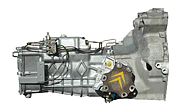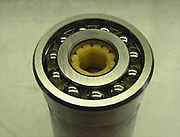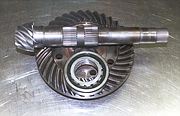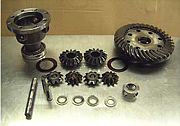The gearbox allows the following functions:

- to increase the engine torque
- to enable a free-wheel or neutral position
- to be able to reverse.
The gearbox – perhaps should more aptly be called a reduction box – makes it possible reduce the engine speed to the wheels, so that the engine can remain at a relatively high speed while driving at slower speeds. This way the engine torque can remain at optimum levels while transmitting most of the power to the wheels
Bearings
Various bearing constructions are used in the Citroën ID, DS and SM gearboxes (as well as Lotus Esprit & Maserati Merak).
The front primary and secondary shafts run on double-rowed angular contact bearings. The rear of the secondary shaft runs on a cylinder bearing and the primary shaft run on a ball bearing. The differential runs on 2 tapered roller bearings with the differential shaft journals being fitted with doubled sided angle contact bearings. The gearwheels rotate freely over the shafts and are fitted with needle roller bearings. The special front flanged bearings are very difficult to obtain and very expensive. Harry Martens Limmen has therefore developed replacement bearings for these
Synchromesh
When two gearwheels mesh together this should take place silently; but this can only happen when both wheels are either completely motionless, or if the speed of rotation at the circumferences is the same. Otherwise the gearbox will make a loud crunching sound. The pair of gearwheels are in constant mesh although not connected to the main shaft. Therefore when a gear is selected, the relative gearwheel should be silently engaged with the main shaft. The gearwheel is then locked onto the main shaft and rotates along with it. The blocking pins in the drum are pushed outwards by the pressure of the springs and clamped to the selector rings. There is a groove in the selector ring for the selector fork. On both sides of the synchronising drum there are unengaged synchromesh rings synchromesh rings. The ring conically shaped on the inside. The same conical shape can be found again, but now as a cone on the gearwheel to be synchronised. There is a gear ring behind the cone. The blocking pin is not only to be found in the synchronising drum, but also in the recesses in the  synchromesh rings. If the main shaft is rotating then the blocking pin will force the synchromesh rings to do the same. If the selector ring slides into the gearwheel, the synchronising drum remains in position but the blocking pins slide along in the drum with the selector ring. The blocking pins now work as pressure pins and press the synchromesh rings onto the conical part of the gearwheel. Because the friction synchronisation now takes place. (Engine disconnected) The friction occurs through the contact of metal. For this reason the conical part of the ring has teeth. The teeth penetrate the oil film and the resulting metal contact with the gearwheel can create such a high temperature that the tips of the gearwheels begin to melt. However this is avoided because of the oil lying on the bottom of the tooth which in turn cools it off. After synchronisation the blocking pins and synchromesh rings cannot move on, but are released by the pressure which continues to be exerted on them selector ring. With its internal gearing the selector ring slides along over the gear ring on the gearwheel with any crunching. If the synchronisation ring becomes worn if travels further up the conical part of the gearwheel resulting in an unsatisfactory braking effect. The synchromesh ring should be replaced.
synchromesh rings. If the main shaft is rotating then the blocking pin will force the synchromesh rings to do the same. If the selector ring slides into the gearwheel, the synchronising drum remains in position but the blocking pins slide along in the drum with the selector ring. The blocking pins now work as pressure pins and press the synchromesh rings onto the conical part of the gearwheel. Because the friction synchronisation now takes place. (Engine disconnected) The friction occurs through the contact of metal. For this reason the conical part of the ring has teeth. The teeth penetrate the oil film and the resulting metal contact with the gearwheel can create such a high temperature that the tips of the gearwheels begin to melt. However this is avoided because of the oil lying on the bottom of the tooth which in turn cools it off. After synchronisation the blocking pins and synchromesh rings cannot move on, but are released by the pressure which continues to be exerted on them selector ring. With its internal gearing the selector ring slides along over the gear ring on the gearwheel with any crunching. If the synchronisation ring becomes worn if travels further up the conical part of the gearwheel resulting in an unsatisfactory braking effect. The synchromesh ring should be replaced.
Crown wheel and pignion
Although his final reduction gearing is very strongly constructed it can suffer from defects and excessive play through aging, insufficient lubrication and over-loading. The teeth of the crown wheel and pinion and differential can become badly worn and pitted or even crack and break off.

Worn bearings can cause excessive play between the gear teeth. Overloading can cause the crown wheel to become deformed, introducing imbalance, resulting in excessive wear on the teeth. New (or good second-hand) crown wheels and pinions are ground and matched, being supplied as pairs. These parts should never be replaced singly, but in pairs. On the head of the pinion and on the crown wheel the part number and meshing depth adjustment are engraved. The ratio is chosen so that the same teeth do not always touch one another. (7/34 or 8/35 ) The aim of the adjustment. Is to produce as little noise as possible when in operation. The fixing of the correct adjustment and tooth profile is only possible with a new crown wheel and pinion. As soon as there is wear and readjustments have to be made, it is no longer possible to fix at the two control points and so a compromise has to be established to enable relatively silent operation.
The complete crown wheel has to be checked for wobble. As soon as the permissible wobble is exceeded, the play between the teeth is negatively influenced, and proper adjustment is no longer possible.
Differential
If both the crown wheel and the wheels on the axle are fixed, this should not impede foreword or backward movement. On curves however, the inner wheel has to travel a shorter distance than the outer wheel. Both wheels should therefore be able to rotate independently of each other and at different speeds. Therefore the crown wheel is not attached directly to the shaft. There is a differential positioned between the crown wheel and the drive shafts. This differential consists of four small gearwheels, called satellite gears, three shafts and a universal junction to which the satellite gears are attached along with two larger gearwheels, or so-called sun gears. The satellites gears rotate directly on their shafts, therefore steel on steel, which naturally leads to shaft wear, causing at lot of play in the differential. These are manufactured by Harry Martens of Limmen.

